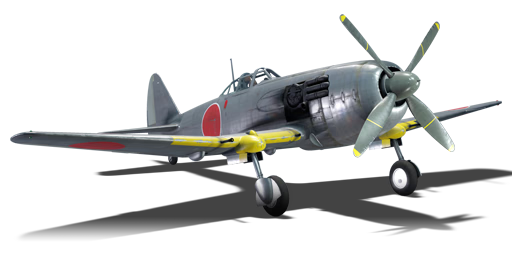



The Ki-87 was a high-altitude fighter-interceptor designed to counter the American B-29 Superfortress raids on Japan. It was powered by a Nakajima Ha-44-12 radial engine with an exhaust-driven turbo-supercharger, which gave it a high performance at altitudes above 10,000 meters. The Ki-87 had a pressurized cockpit, a four-bladed propeller, and a rearward folding undercarriage. It was armed with two 30 mm and two 20 mm cannons, and could carry a 250 kg bomb under the fuselage. The Ki-87 was developed from 1942, but faced delays due to technical problems and material shortages. Only one prototype was completed and flown in April 1945, but no production aircraft were built before the end of the war.
It was introduced in Update 1.63 "Desert Hunters" as a pack vehicle. The Ki-87 is a Japanese super prop with a powerful armament and a turbo-supercharger. It performs poorly in sharp turns, rolls slowly, and overheats on WEP. Manual engine control is needed to optimize its performance. The Ki-87 excels at high altitude combat, where it can outperform many planes and dive at high speeds. The cannons are very effective and can destroy bombers easily. The Ki-87 has a fair climb-rate and is able to maintain energy after a dive to regain altitude. The recommended settings are minimum fuel, 500 m gun convergence, vertical targeting, tracer belts for 30 mm and universal belts for 20 mm.
The Ki-87 was discontinued from the store after the 2018 Independence Day Sale, but was brought back for War Thunder's 7th Anniversary as a premium purchasable in-game for 6,090 Golden Eagles.
flaps
flaps
flaps
brake
| Belt | Belt filling | Armor penetration (mm) at a distance: | |||||
|---|---|---|---|---|---|---|---|
| 10 m | 100 m | 500 m | 1000 m | 1500 m | 2000 m | ||
| HEF/AP-T/HEF-I | 28 | 26 | 18 | 11 | 7 | 5 | |
| HEF-I/AP-T/AP-T/HEF/HEF | 28 | 26 | 18 | 11 | 7 | 5 | |
| HEF-I/AP-T/AP-T/AP-T/AP-T | 28 | 26 | 18 | 11 | 7 | 5 | |
| AP-T | 28 | 26 | 18 | 11 | 7 | 5 | |
| HEF | 3 | 3 | 3 | 3 | 3 | 3 | |
| Belt | Belt filling | Armor penetration (mm) at a distance: | |||||
|---|---|---|---|---|---|---|---|
| 10 m | 100 m | 500 m | 1000 m | 1500 m | 2000 m | ||
| HEF-I/P/AP-T | 27 | 25 | 17 | 10 | 6 | 4 | |
| HEF-I/HEF-I/AP-T | 27 | 25 | 17 | 10 | 6 | 4 | |
| AP-T/AP-T/HEF-I | 27 | 25 | 17 | 10 | 6 | 4 | |
| AP-T | 27 | 25 | 17 | 10 | 6 | 4 | |
| HEF-I/HEF-I/HEF-I/P | 16 | 13 | 8 | 6 | 0 | 0 | |







 2 x (110 / 235 / 510) %
2 x (110 / 235 / 510) % 
 2 x 178 %
2 x 178 % 

Flight performance | |
|---|---|
Survivability |
|---|
Weaponry | |
|---|---|